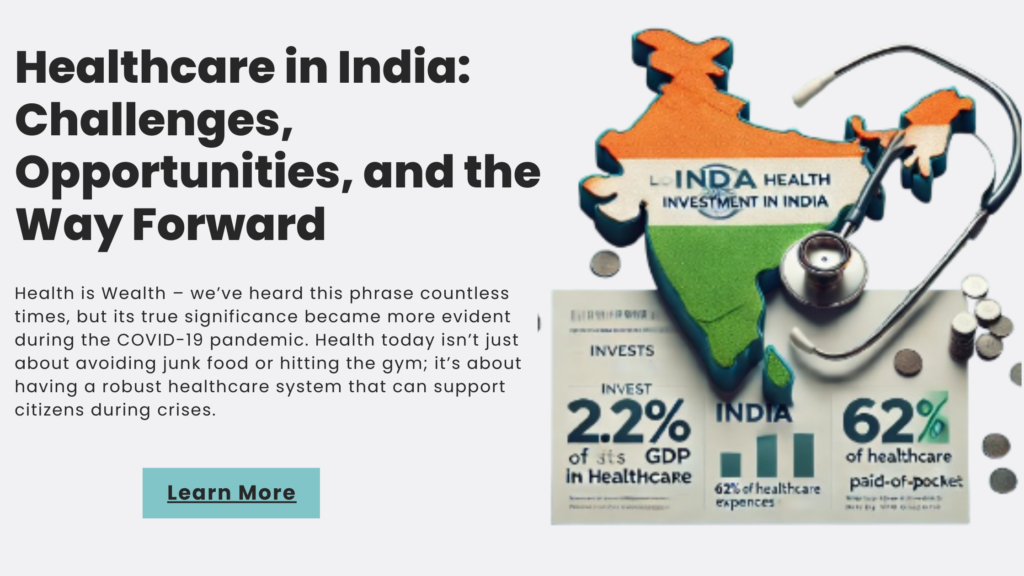Low Health Investment in India: A Growing Crisis and Its Impact on Public Health

In India, healthcare remains one of the most crucial aspects of the nation’s development. However, despite the importance of health, the country continues to invest a shockingly low percentage of its GDP in healthcare, which is one of the lowest in the world. India spends only 2.1% of its GDP on healthcare, a stark contrast to the average expenditure in G20 countries. In this blog post, we will delve into the reasons behind low health investment in India, the implications of this underfunding, and explore solutions for improving healthcare access for all Indians.
The lack of proper healthcare investment is a problem that affects everyone, but it hits the most vulnerable groups the hardest. Join us as we explore how this issue is shaping the health landscape in India and what needs to be done to change it.
Understanding the Importance of Healthcare Investment
A robust healthcare system is essential for the prosperity of any country. It ensures that all citizens, regardless of their financial status or geographical location, have access to the services they need for healthy living. Proper healthcare investment allows for better public health infrastructure, accessible medical care, and improved health outcomes for individuals and communities. Unfortunately, India’s healthcare system is underfunded, which compromises the quality of care available to the general public.
The Current State of Healthcare Spending in India
India’s healthcare spending stands at only 2.1% of its GDP, one of the lowest globally. This inadequate allocation limits the development of essential healthcare facilities, the expansion of public healthcare services, and the recruitment and training of skilled healthcare workers. For context, most developed countries spend between 8-10% of their GDP on healthcare. This disparity has a far-reaching impact on the healthcare system, resulting in poor access to medical care, long waiting times, and poor-quality services in government hospitals.
The Burden of Out-of-Pocket Expenses on Indian Citizens
An alarming statistic that highlights the severity of the situation is that 62% of healthcare costs in India are paid out-of-pocket by the citizens. This burden often falls on individuals who can least afford it, forcing many to delay medical treatment or skip necessary procedures altogether. The inability to pay for healthcare results in deteriorating health conditions and, in some cases, avoidable deaths. Out-of-pocket expenses also push many families into debt, further exacerbating their financial struggles.
Public Healthcare Facilities: A Weak Link in the System
The public healthcare system in India is often described as underfunded and overcrowded. Government-run hospitals are plagued by inadequate infrastructure, insufficient staff, and lack of modern medical equipment. These shortcomings force many individuals to seek treatment in expensive private healthcare facilities, which are beyond the financial reach of many.
This disparity in healthcare access between the rich and poor is one of the most significant challenges facing the Indian healthcare system today.
The Challenge for the Common Man: Inadequate Healthcare Access
For millions of Indians, particularly in rural areas, healthcare is a challenge. Rural healthcare facilities are sparse, underfunded, and often lack qualified healthcare professionals. As a result, many people have to travel long distances to access quality medical care, which is often too expensive. For those living in poverty, this situation can lead to untreated illnesses and deteriorating health. The divide between the quality of healthcare available in urban versus rural areas highlights the inequality that exists within the system.
Why Healthcare Should Be a Basic Right in India
Healthcare is more than just a service; it is a fundamental human right. Every Indian citizen deserves access to quality healthcare, regardless of their socio-economic status or geographical location. Health is a critical determinant of overall well-being, and investing in healthcare is an investment in a nation’s future. The government must prioritize healthcare as a basic right and allocate a fair share of its budget to improve healthcare infrastructure, train healthcare professionals, and reduce the burden on the common man.
What Needs to Change: How Can We Improve Healthcare in India?
To address the challenges posed by low healthcare investment, several actions must be taken. Here are a few solutions that could bring significant improvements to the healthcare system in India:
1. Increasing Healthcare Budget Allocation
The government must increase the percentage of GDP allocated to healthcare, aiming to bring it closer to the global average. Higher investment will allow for the development of better public healthcare infrastructure, improved healthcare services, and reduced reliance on private healthcare.
2. Strengthening Public Healthcare Systems
There is an urgent need to modernize and expand public healthcare facilities across India. This includes improving hospital infrastructure, increasing the availability of medical equipment, and hiring more trained healthcare professionals. Strengthening public healthcare would ensure that medical services are more accessible and affordable for all citizens.
3. Embracing Public-Private Partnerships
The Indian government should collaborate with the private sector to improve the healthcare system. Public-private partnerships can help bridge the gap in healthcare delivery by pooling resources, expertise, and technologies to enhance care accessibility and quality across the country.
4. Improving Healthcare Access in Rural Areas
India must focus on improving healthcare access in rural areas. This can be done by building new healthcare centers, increasing telemedicine services, and offering mobile health clinics. Additionally, incentivizing healthcare professionals to work in rural areas could help alleviate the shortage of medical staff.
Aapka Care: Leading the Charge for Better Healthcare
In the face of these challenges, it is important to highlight institutions like Aapka Care, one of the best healthcare centers in Mumbai and Noida. Aapka Care is committed to improving patient outcomes by providing comprehensive healthcare services, from consultations to surgery and post-surgery care. By leveraging cutting-edge technologies and providing personalized care, Aapka Care aims to make healthcare more affordable and accessible for all.
What Can You Do to Support Better Healthcare in India?
As citizens, it is our responsibility to raise awareness about the importance of healthcare investment and support initiatives that focus on improving healthcare access. Supporting government policies aimed at increasing healthcare spending, advocating for better healthcare facilities, and using platforms like Aapka Care for medical support can collectively contribute to creating a healthier India.
Conclusion: A Call to Action for India’s Healthcare System
In conclusion, the low health investment in India is a serious issue that needs immediate attention. The lack of proper healthcare funding and the resulting disparities in healthcare access have created a system that leaves millions of people at a disadvantage. To address this problem, the government must increase healthcare spending, strengthen public healthcare systems, and collaborate with the private sector to improve access to affordable care. Healthcare should be considered a basic right for every citizen, and by investing in this vital sector, India can build a healthier and more prosperous future.
For more insights and healthcare tips, be sure to follow Aapka Care, watch our YouTube video on healthcare solutions, and stay tuned for more updates!



